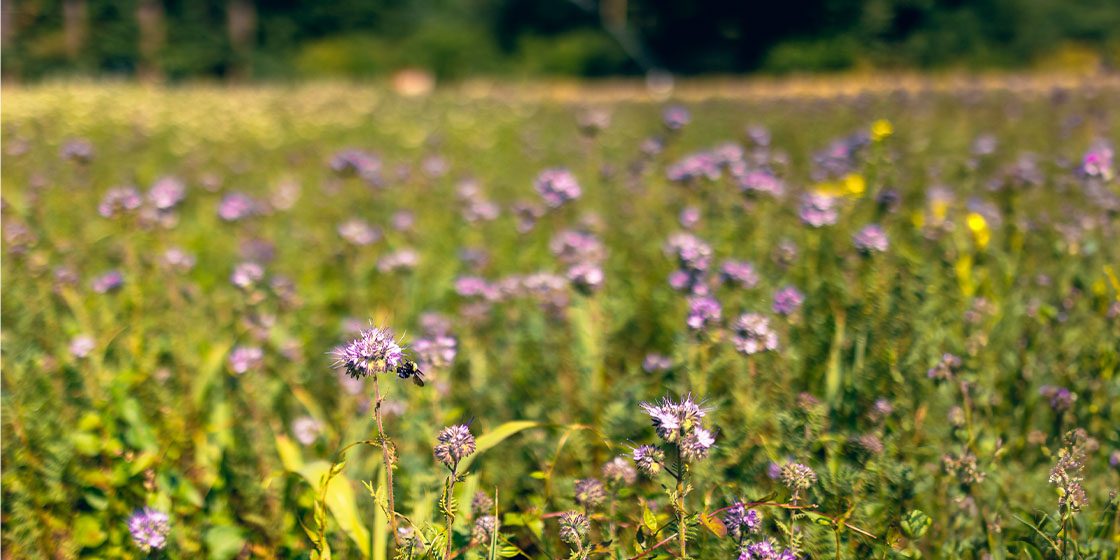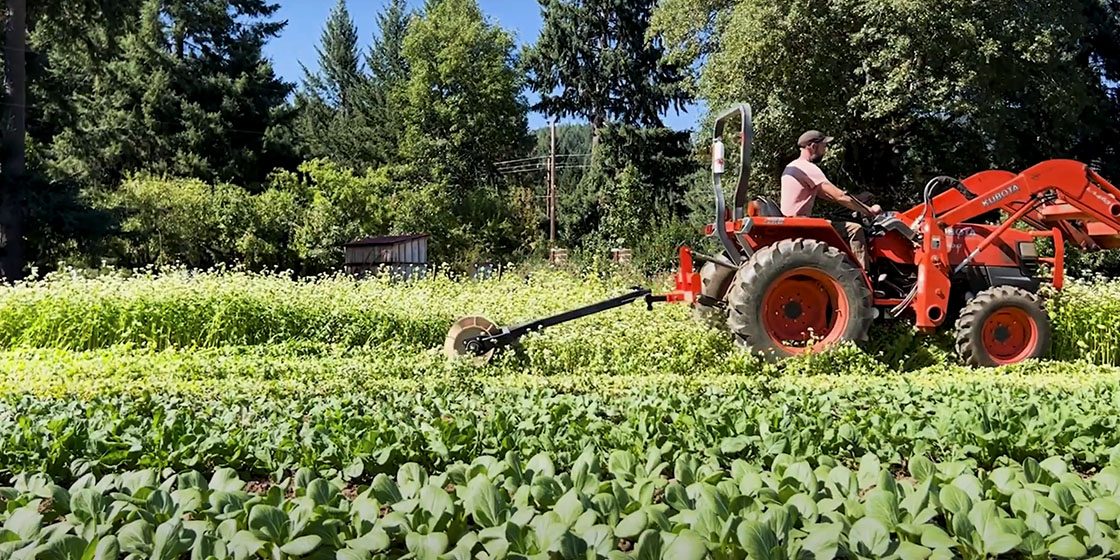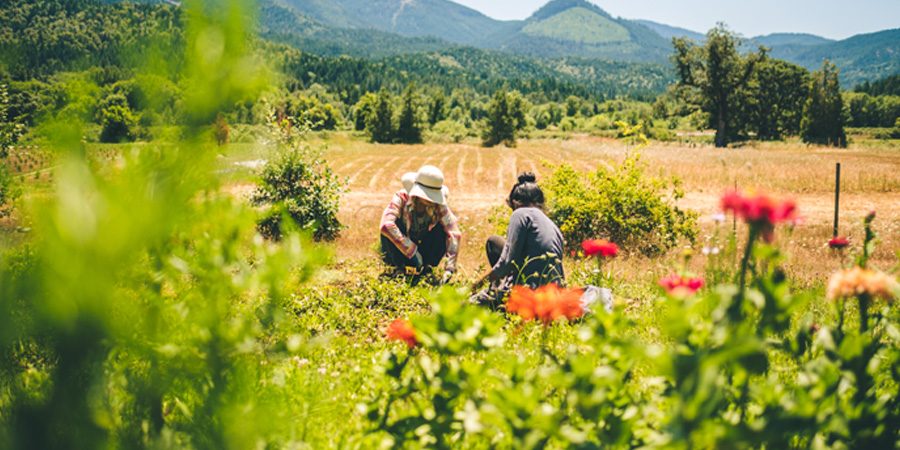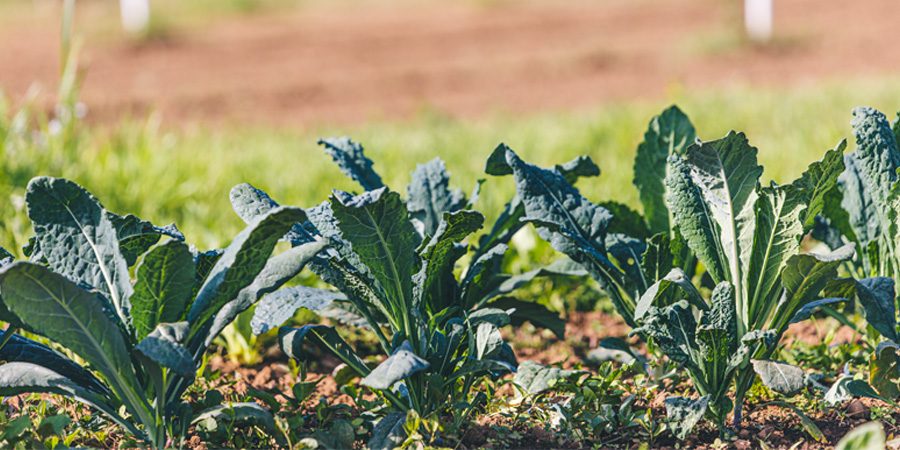Regenerative Agriculture: The Practices, Principles, and Benefits
As more and more people are turning to the ancient wisdom of Ayurveda and other traditional healing practices to support their health, a growing number of farmers are rediscovering a more harmonious way of growing food that supports a healthy planet.
Regenerative agriculture, rooted in traditional and indigenous practices, focuses on working in harmony with nature to farm in a way that restores the health of our ecosystems and ensures a flourishing future for all.
This article explores the benefits and practices of regenerative agriculture and introduces some of the ways that Banyan Botanicals is embracing and implementing its core principles.
In this article:
- What Is Regenerative Agriculture?
- The Core Principles and Practices
- Why Regenerative Agriculture Matters
- Regenerative Agriculture at Banyan Farm
- What’s Next? Our Future Vision
What Is Regenerative Agriculture?
Regenerative agriculture is a holistic approach to farming and land management that fosters healthy, thriving ecosystems and contributes to the well-being of the planet and future generations.
While the concept of regenerative agriculture may just be finding its way into mainstream terminology, the principles and practices of regeneration have been around for thousands of years.
The modern regenerative agriculture movement borrows from traditional knowledge, working to replenish and enhance our natural ecosystems while nurturing soil health, enhancing biodiversity, addressing pressing environmental concerns, and meeting global food demands.
By going a step beyond sustainable sourcing and mere harm reduction, regenerative agriculture presents a powerful opportunity to actively rebuild the health of the planet and forge a path towards long term environmental resilience.
Ayurveda and Regenerative Agriculture
Furthermore, the principles of regenerative agriculture align harmoniously with Ayurveda. Ayurveda recognizes the environment as an integral component of human health and acknowledges the interdependence between our well-being and the planet's well-being.
Consider the analogy between poor soil and an imbalanced diet—similar to how we require a nutritious diet to support our well-being, plants also rely on the nourishment provided by healthy soil in order to flourish. The regenerative farming approach uses holistic practices to support optimal balance throughout the entire ecosystem.

The Core Principles and Practices
So what exactly makes regenerative agriculture different from more conventional methods of farming?
Conventional farming focuses on prioritizing productivity and increasing crop yields. Over time, this has led to practices that harm the environment, including but not limited to the use of synthetic chemicals, genetically modified organisms, deforestation, greenhouse gas emissions, water depletion, and soil degradation.
Regenerative agriculture, on the other hand, works with nature-positive practices that help to restore the environment to a state of thriving health. While regenerative practices tend to increase crop yield and abundance over time, this is not the main goal.
At a glance, the key practices and principles of regenerative agriculture are:
- cover cropping
- composting
- minimizing soil disturbance
- encouraging plant diversity
- planting continual live plants
- integrating livestock
Let’s take a closer look at these key principles that make up this proactive and multifaceted approach to land-tending.

Cover Cropping
Soil health is one of the most important factors in regenerating healthy ecosystems.
Defined as “the ability of the soil to sustain the productivity, diversity, and environmental services of terrestrial ecosystems,”1 healthy soil is generally agreed to be rich in nutrients, have a porous physical structure that retains more moisture and oxygen, and host an abundance of microbes such as bacteria and fungi.2
When soil is left bare, it is prone to erosion, weeds, and severe depletion of the nutrients that maintain a healthy population of microorganisms.
Therefore, a fundamental component to improving the soil is to keep fields planted at all times, or at least as often as possible. Enter the practice of cover cropping—also known as soil armor.
What is cover cropping, exactly? Different from the main crops grown for profit, cover crops are planted in between growing seasons for the purpose of building healthy and resilient soil. They help prevent soil erosion, enhance soil fertility, retain moisture, suppress weeds, and promote beneficial soil microbial activity.3
Composting
When it comes to why composting is important in regenerative agriculture, it transforms organic waste into nutrient-rich humus, improving soil structure, health, and fertility. It also helps to enhance soil moisture retention, minimize plant diseases, and promote beneficial microbial activity.
By using compost to feed nutrients back to the soil, regenerative farming reduces landfill waste while fostering what is called a closed nutrient loop—a cycle that minimizes the need for synthetic fertilizers and other costly inputs sourced from outside the farm.4

Minimize Soil Disturbance
In conventional farming, regular tilling disturbs and devastates soil biology by disrupting the network of live organisms that live below the surface and contribute to thriving plant life. It also opens the soil for potential pathogens, increases the risk of erosion, and releases vital moisture.5
Minimizing soil disturbance, also known as no-till farming, utilizes techniques like direct seeding or planting into undisturbed soil in order to reduce the damage of mechanical soil tillage.
This approach preserves the delicate structure of the soil, helps retain precious moisture content, increases beneficial organic matter, and protects and enhances the natural biodiversity found in the underground ecosystem—from worms to bacteria to beneficial mycelial webs.
Plant Diversity
The concept of diversity in farming refers to the intentional cultivation of a wide range of different plant species.
By embracing diverse crop rotations, intercropping, and growing several different plant species, regenerative farmers enhance the mineral and nutrient content of the soil, control pests and diseases naturally, and provide habitat for beneficial organisms to thrive.
This practice also attracts a diversity of birds and pollinators, which in turn further contributes to healthy overall biodiversity and resilience across the ecosystem.
Continual Live Plants
Similar to soil armor, this principle refers to the practice of maintaining a living cover on the land throughout the year with cover crops, trees, or perennials.
When living, photosynthesizing plants are in the ground, they capture carbon from the atmosphere and sequester it in the soil, contributing to a healthy abundance of microbial life that then feeds back into healthy and nutrient-rich crops.6
Keeping the soil surface vegetated with a diverse array of plants has several benefits—it builds healthy soil, supports beneficial microorganism activity, and promotes the cycling of nutrients through the ecosystem.
Livestock Integration
Livestock integration involves strategically incorporating animals, such as chickens, ducks, or cows, and carefully managing their movement and grazing patterns to optimize the effects they have on the land.
This integration mimics natural ecological processes, benefits pasture ecosystems, and contributes to sustainable land management practices. It also provides a source of food and livelihood for farmers, as well as compost material and natural fertilizer for the farm.
In this way, livestock integration further supports the beneficial practice of a closed nutrient loop and reduces the need for costly chemical fertilizers.

Why Regenerative Agriculture Matters
In the face of the increasing social and environmental challenges of our times, regenerative agriculture offers a proactive solution and a glimmer of hope for our future.
By honoring traditional practices of working in harmony with the land, regenerative agriculture actively seeks to improve and enhance the overall health of the ecosystem, not only healing the damage that has been caused by conventional farming but also contributing to future abundance and resiliency.
But that’s not all! What follows are just some of the myriad benefits of regenerative farming, which are both environmental and social in nature.
4 Key Environmental Benefits
1. Soil Health
Regenerative practices such as cover cropping, crop rotation, and minimal tillage help improve soil health in a number of ways.
They increase organic matter in the soil, promote beneficial microbial activity, and enhance nutrient cycling—the process of moving nutrients from the environment to living organisms and back again.7
Regenerative practices also lead to improved soil structure, water retention, and carbon sequestration, ultimately combating soil erosion and degradation over time while contributing to a healthier and more abundant environment.
2. Water Conservation
Regenerative agriculture plays a crucial role in water conservation by promoting practices that minimize water runoff and increase water infiltration into the soil.
Additionally, healthy and well-structured soils have a higher water-holding capacity, reducing the need for irrigation and helping crops withstand drought conditions.
This sustainable water management not only supports agricultural production but also contributes to overall watershed health and the availability of clean water resources.
3. Biodiversity Conservation
By embracing diverse crop rotations, intercropping, and the preservation of natural habitat, regenerative agriculture fosters and protects an abundance of biodiverse life forms.
This, in turn, promotes the presence of even more beneficial insects, birds, and pollinators, and supports an abundant biodiversity of local wildlife.
This biodiversity extends beyond the borders of the farmland into neighboring ecosystems, acknowledging the inherently interconnected nature of the land and all its living inhabitants.
4. Climate Resilience
Regenerative agriculture practices turn agriculture from a climate problem into a climate solution by storing more carbon in the ground than is released into the atmosphere while farming. This is sometimes referred to as carbon farming or climate smart agriculture.8
How does it work, exactly? Biodiverse ecosystems and the presence of healthy green plant life help to absorb the greenhouse gasses emitted by human activity through the process of photosynthesis.
The beneficial, life-supporting carbon from these gasses is sequestered in the plants and the soil, contributing to a cleaner atmosphere as well as healthier soil, plants, and ecosystems.9
Additionally, the improved water management and reduced reliance on chemical fertilizers lower the overall carbon footprint and contribute to positive climate action when compared to conventional farming.
4 Key Social Benefits
1. Healthy and Nutritious Plants
By focusing on soil health and enhancing nutrient availability, regenerative agriculture fosters the most nutrient-dense food and herbs possible.
As a result, regeneratively grown produce can exhibit higher levels of vitamins, minerals, antioxidants, and phytonutrients, contributing to improved human health and well-being.
2. Food Security and Safety
Regenerative practices promote diversified and locally adapted farming systems, reducing dependence on a limited number of crops and enhancing food security by ensuring a resilient and varied food supply.
Regenerative practices also minimize or eliminate the use of chemical pesticides and fertilizers, which means increased safety and health both for the farmer working in the fields and the consumers eating the food.
3. Economic Opportunities
Regenerative agriculture provides economic benefits for farmers through reduced input costs, increased productivity, and enhanced market opportunities for sustainably produced goods.
Rather than relying on conventional monocrops, regenerative farmers can improve their resilience to climate variability and market fluctuations by planting a variety of crops.
4. Community Well-Being
Regenerative agriculture fosters community engagement and knowledge sharing. It encourages farmer-to-farmer collaboration, local food systems, and direct relationships between farmers and consumers.
These connections enhance social cohesion, support rural economies, and promote a sense of pride.
Furthermore, engaging in regenerative practices naturally cultivates a more direct and harmonious relationship with the land and an opportunity to reconnect with the rhythms and cycles of nature.

Regenerative Agriculture at Banyan Farm
For the last three years, Banyan Botanicals has been partnering with Banyan Farm in Southern Oregon to implement regenerative farming principles and study the effects of these practices over time.
Certified organic and 100 percent chemical-free (which goes above and beyond the requirements of organic farming), focusing on regenerative agriculture is the natural next step at Banyan Farm.
Much like the Ayurvedic path to healing, regenerative practices are not a quick fix or a way to change everything overnight.
With this intention as our guide, we have begun to implement the following regenerative practices at Banyan Farm:
Cover Cropping
In alignment with the principle of soil armor, Banyan Farm works with year round cover cropping in the fields in an effort to rebuild soil health and fertility and support pollinator habitat. Cover crops include a mix of oats, vetch, peas, clover, and a custom pollinator blend as advised by Bee Girl Organization.
Along with all the benefits outlined above, this cover crop mix is specifically designed to be a nitrogen fixer, drawing nitrogen out of the atmosphere into the soil to make it available for future plant growth.
Composting
Through the practice of composting, all processed plants, food, or veggie scraps are mixed with local organic cow manure and turned into nutrient-rich fertilizer. This is then added back into the fields, along with topsoil mulch, to enhance soil fertility and nourish the vitality and abundance of the crops.
Crop Rotation
The practice of crop rotation is another way of preventing soil depletion and ensuring healthy soil over time by exposing it to a variety of plant species, each with different nutritional contributions.
At Banyan Farm, the farmers rotate crops on a three to seven year cycle. For example, skullcap was planted in one field in 2020 and won’t be planted there again until 2024.
Reducing Soil Disturbance
While Banyan Farm is not entirely till-free as a whole, it has reserved an experimental plot that is dedicated completely to regenerative practices. For the past three years, this plot has been completely free of soil disturbance from tilling, relying instead on the benefits of compost and cover crops.
This experimental plot is being carefully monitored over time and has already transformed greatly, with rich fertile soil and an abundant presence of mycelial webs visible to the naked eye.
This plot also serves as a living, growing research lab. The crops grown there—currently tulsi and ashwagandha—will be laboratory tested for individual constituent levels and compared to the same plants in other tilled fields on the farm.
Over the course of many years, we expect this information to provide valuable insights into the benefits of regenerative agriculture on the health of the plants and herbs, and in turn, their potential to support human health.
Diversity
Being inspired by Ayurveda’s acknowledgement of the interconnectedness of all of life, the Banyan farmers understand that the farm is not separate from the wild lands that surround it.
With this in mind, they are passionate about supporting the seamless weaving of the farm and the neighboring wilderness in a mutually beneficial and harmonious way.
How to go about this? Supporting healthy and abundant biodiversity!
Currently, the farm is home to around 45 different vegetables, 18 main varieties of herbs, 9 cover crop variations, several species of fruit trees, and an education garden with nearly 100 species of plants.
As such, the farm supports a huge variety of life, increasingly becoming a sanctuary for birds, wildlife, and local pollinators.
Through our biodiversity project with Bee Girl Organization, we have already identified 25 different types of pollinators—a beautiful sign that we are successfully supporting greater biodiversity through regenerative farming practices.

What’s Next—Our Regenerative Agriculture Vision
At the heart of Banyan’s vision and mission is a commitment to supporting and empowering healthy people—in a way that also supports a healthy planet.
Regenerative agriculture is a natural and perfectly aligned next step in this journey, which is why we are investing in regenerative practices and striving to increase the amount of ingredients in our product line that are grown regeneratively.
Along with our partners at Banyan Farm, we are excited to continue implementing regenerative principles in the years to come, going above and beyond our commitments to organic certification and sustainable sourcing and leading the way into a truly vital and abundant future.
By integrating these learnings, we can work to promote farming practices that honor the Earth's wisdom, benefit the health of our human, plant, and animal communities, and ensure a flourishing future for all.


